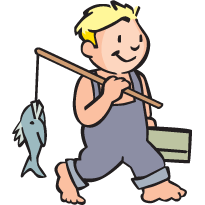Boston Children's Museum
308 Congress Street, Boston, MA 02210
617-426-6500
© Boston Children’s Museum 2025
Website Design by JackrabbitChildren are familiar with celebrations like Thanksgiving, Christmas and New Year’s Day, but there are many other celebrations recognized by other cultures that your students may be less familiar with. By learning about these celebrations, children can gain insight not only into the customs of other cultures, but they can come closer to understanding and appreciating the diversity of some of their peers as well. Spring is the time of year that Wampanoag culture gives thanks for the herring that fill the rivers and streams. This activity introduces students to the methods by which the Wampanoag traditionally caught herring and other fish.
Create a “river” using tables laid down on their side, boxes stacked in a row or any other method. You will need to create a “corridor” that is several feet long (6–10 feet) and about 3 feet wide. This will be your river—you will be blowing air along this corridor, simulating the water that flows in a river.
Cut out a few small paper fish for your own use (the fish don’t need to look perfect). The fish can vary in size from 3 to 10 inches long. Experiment with using the fan to blow the “fish” down the river. If your fan is too powerful, try weighting the fish by taping paper clips to them, or simply using wadded up pieces of paper.
Prior to trying this activity, read “Wampanoag New Year“ and “Introduction to the Wampanoag People”from the Wampanoag Celebrations in Spring Story activity.

Ask your students if they have ever gone fishing. Did they catch any fish? How did they do it? How fast do they think herring move in rivers and streams? What would be a good method for catching them? You can tell your students that when the herring run very well (meaning there are lots of them), people living nearby often catch them with their bare hands! Fishing poles and various nets are possible methods too.
Create a contraption that will catch the “herring” in the “river” you teacher has set up!
After teams have been working for 10–15 minutes, bring your students together for a brief discussion. What are their ideas for creating a fish catcher? How will they test it out? Listen for kids saying they can blow the fish across the table they are working on in order to test their creations. How many fish do they think they will catch? If no teams are creating a net that will stretch across the end of the “river”, find ways to ask questions that might lead some teams to this idea. Ask them how they might catch lots of fish at once. How do fishermen in different parts of the world catch lots of fish at once? This discussion should last no more than a few minutes.
Send the teams back to work. When teams have prototypes that they would like to test, invite them to the river, where they can set up their fish at the beginning and their fish catcher at the end. Set up the fan and blow the fish down the river for them. Did their fish catcher work as well as they would have liked it? If not, what changes can they make?
Teams will most likely only have an early model of their fish catcher after about an hour. This is a good time to stop. You should conduct this activity over 2 sessions. Take a day or two off, putting their designs aside, then talk to them about what they did in the first session. What will they do to improve their design? Let each team continue working on their fish catcher (including testing their designs at the river) and continue the activity until every team has a working creation. Then, bring everyone together and have each team demonstrate their invention.